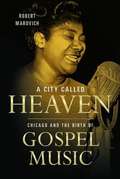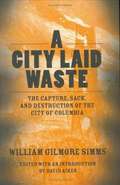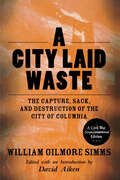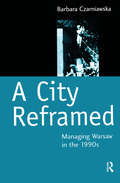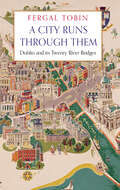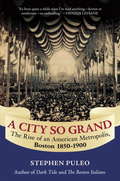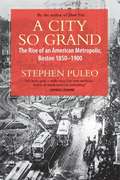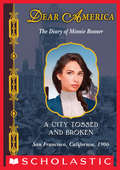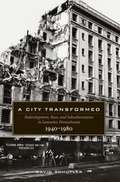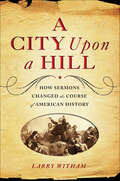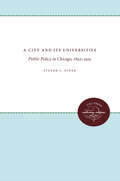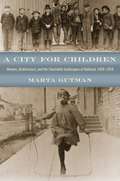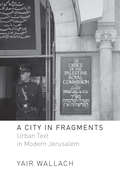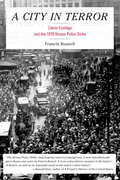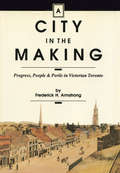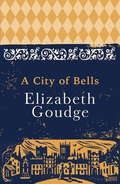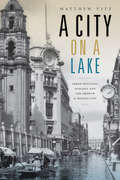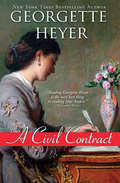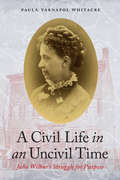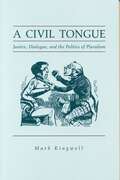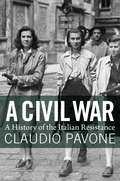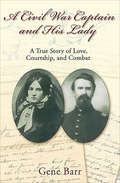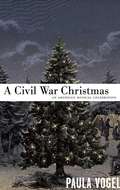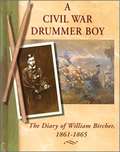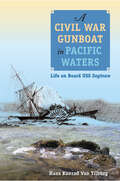- Table View
- List View
A City Called Heaven: Chicago and the Birth of Gospel Music
by Robert M. MarovichIn A City Called Heaven, gospel announcer and music historian Robert Marovich shines a light on the humble origins of a majestic genre and its indispensable bond to the city where it found its voice: Chicago. Marovich follows gospel music from early hymns and camp meetings through the Great Migration that brought it to Chicago. In time, the music grew into the sanctified soundtrack of the city's mainline black Protestant churches. In addition to drawing on print media and ephemera, Marovich mines hours of interviews with nearly fifty artists, ministers, and historians--as well as discussions with relatives and friends of past gospel pioneers--to recover many forgotten singers, musicians, songwriters, and industry leaders. He also examines how a lack of economic opportunity bred an entrepreneurial spirit that fueled gospel music's rise to popularity and opened a gate to social mobility for a number of its practitioners. As Marovich shows, gospel music expressed a yearning for freedom from earthly pains, racial prejudice, and life's hardships. In the end, it proved to be a sound too mighty and too joyous for even church walls to hold.
A City Laid Waste: The Capture, Sack, and Destruction of the City of Columbia
by William Gilmore SimmsA City Laid Waste captures in riveting detail the destruction of South Carolina's capital city, a native South Carolinian and one of the nation's foremost men of letters, was in Columbia and witnessed firsthand the city's capture by Union forces and its subsequent devastation by fire. Simms recorded the events in a series of eyewitness and accounts published in the first ten issues of the Columbia Phoenix.
A City Laid Waste: The Capture, Sack, and Destruction of the City of Columbia
by William Gilmore Simms“A graphic account of the horrors, the brutality and sometimes wanton destruction of warfare, particularly of civil war.” —Charleston (SC) Post and CourierIn the first reissue of these documents since 1865, A City Laid Waste captures in riveting detail the destruction of South Carolina’s capital city. William Gilmore Simms (1806-1870), a native South Carolinian and one of the nation’s foremost men of letters, was in Columbia and witnessed firsthand the city’s capture and destruction. A renowned novelist and poet, who was also an experienced journalist and historian, Simms deftly recorded the events of February 1865 in a series of eyewitness accounts published in the first ten issues of the Columbia Phoenix and reprinted here. His record of burned buildings constitutes the most authoritative information available on the extent of the damage. Simms historian David Aiken provides a historical and literary context for Simms’s reportage. In his introduction Aiken clarifies the significance of Simms’s articles and draws attention to factors most important for understanding the occupation’s impact on the city of Columbia.“A shrewd viewer of the war scene in Columbia, famed Southern writer William Gilmore Simms published stinging, courageous exposés of the doings of the Northern forces, even when threatened with arrest. The restoration of his candid firsthand accounts of the destruction wrought by Sherman’s forces against the South Carolina capitol and its inhabitants is a great service to all who study and appreciate Southern history and literature.” —James Everett Kibler, author of Our Fathers’ Fields
A City Reframed: Managing Warsaw in the 1990's (Cities And Regions Ser. #Vol. 4)
by Barbara CzarniawskaManagement of big cities is a relatively unresearched area, as compared to city planning and city governance. A study of Warsaw city management reveals the transformation process typically found in European countries in political and economic transition. In A City Reframed, Czarniawska conceptualises city management as an "action-net" under transformation, where three types of action are in focus: "muddling through", or coping with daily problems; "reframing", or changing the frame of interpretation of the world in order to take successful action; and "anchoring", the testing of new ideas on potentially involved parties in order to secure cooperation or minimize resistance. "Muddling through" is central to management in Warsaw, as it no doubt has always been: it is this "muddling through" that makes cities function. The specificity of the Warsaw picture is its demand for "reframing" and numerous and varied attempts have been made to achieve a "change of frame". They were sometimes successful, sometimes not, the skill of anchoring only slowly emerging from the most recent past, with the sediments of the old regimes an obvious obstacle. The study pinpoints the phenomena central to the construction of the action-net of city management, and traces its further connections (or lack of such), both temporally and spatially.
A City Runs Through Them: Dublin and its Twenty River Bridges
by Fergal TobinAn original and fascinating history of Dublin that tells the story of the city through its bridges.Dublin's twenty bridges cross the tidal section of the River Liffey flowing through its centre; they were built over a span of a thousand years. Each has made a contribution to the city's development over time, so much so that it is possible to piece together its history by tracing their construction in chronological order.Starting with Church Street Bridge, Dublin's first, which dates back to the Vikings, and ending with the Rosie Hackett Bridge, erected in 2014, Fergal Tobin charts the rise of Ireland's capital city as never before and reveals how it has been truly made by its bridges.
A City So Grand
by Stephen PuleoOnce upon a time, "Boston Town" was an insulated New England township. But the community was destined for greatness. Between 1850 and 1900, Boston underwent a stunning metamorphosis to emerge as one of the world's great metropolises-one that achieved national and international prominence in politics, medicine, education, science, social activism, literature, commerce, and transportation. Long before the frustrations of our modern era, in which the notion of accomplishing great things often appears overwhelming or even impossible, Boston distinguished itself in the last half of the nineteenth century by proving it could tackle and overcome the most arduous of challenges and obstacles with repeated-and often resounding-success, becoming a city of vision and daring.In A City So Grand, Stephen Puleo chronicles this remarkable period in Boston's history, in his trademark page-turning style. Our journey begins with the ferocity of the abolitionist movement of the 1850s and ends with the glorious opening of America's first subway station, in 1897. In between we witness the thirty-five-year engineering and city-planning feat of the Back Bay project, Boston's explosion in size through immigration and annexation, the devastating Great Fire of 1872 and subsequent rebuilding of downtown, and Alexander Graham Bell's first telephone utterance in 1876 from his lab at Exeter Place.These lively stories and many more paint an extraordinary portrait of a half century of progress, leadership, and influence that turned a New England town into a world-class city, giving us the Boston we know today.From the Hardcover edition.
A City So Grand: The Rise of an American Metropolis, Boston 1850-1900
by Stephen PuleoBetween 1850 and 1900, Boston underwent a stunning metamorphosis from an insulated New England town into one of the world's great metropolises--one that achieved worldwide prominence in politics, medicine, education, science, social activism, literature, commerce, and transportation. In A City So Grand, Stephen Puleo chronicles this remarkable period in Boston's history. He takes readers through the ferocity of the abolitionist movement of the 1850s, the thirty-five-year engineering and city-planning feat of the Back Bay project, Boston's explosion in size through immigration and annexation, the devastating Great Fire of 1872, and the glorious opening of America's first subway station in 1897. This lively journey paints a portrait of a half century of progress, leadership, and influence.
A City Tossed and Broken: A City Tossed And Broken (Dear America)
by Judy BlundellFrom National Book Award-winning author Judy Blundell, a thrilling account of the San Francisco Earthquake of 1906.When Minnie Bonner's father disappears after losing the Bonners' Philadelphia tavern, the wealthy gentleman Edward Sump, led by his avaricious wife, offers Minnie a chance to work as a lady's maid to support her family. The Sumps have grand plans, grander than the city of Philadelphia can offer, however, and decide to move to San Francisco -- the greatest city in the west. But when a powerful earthquake strikes, Minnie finds herself the sole survivor among them. After the dust settles, Minnie discovers a bag belonging to the Sumps filled with cash and papers that could drastically change her fortune. With no one else to claim it, Minnie has turned into an heiress overnight. Wealth comes at a price, though, and she is soon wrapped up in a deception that leads her down a dangerous path. As the aftermath of the earthquake ravages the city, Minnie continues to maintain her new identity. That is, until a mysterious but familiar stranger appears.
A City Transformed: Redevelopment, Race, and Suburbanization in Lancaster, Pennsylvania, 1940-1980
by David SchuylerAs was true of many American cities, Lancaster, Pennsylvania, adopted urban renewal programs in the postwar years to revitalize a downtown that was experiencing economic decline. As the commercial and residential infrastructure of the city decayed, people and jobs migrated to the suburbs. Urban renewal was supposed to make the downtown viable again as a site for both businesses and residences. But as David Schuyler shows in A City Transformed, redevelopment in Lancaster resulted in more failures than successes. Beginning in the 1950s, the Lancaster Redevelopment Authority implemented a comprehensive revitalization program that changed the physical shape of the city. In attempting to solidify the retail functions of the traditional central business district, redevelopment dramatically altered key blocks of the downtown, replacing handsome turn-of-the-century Beaux Arts structures with modernist concrete boxes and a sterile public square. The strategy for eliminating density and blighted buildings resulted in the demolition of whole blocks of dwellings and, perhaps more importantly, destabilized Lancaster's African American community. A City Transformed is a compelling examination of a northern city struggling with its history and the legacy of segregation. But the redevelopment projects undertaken by the city, however ambitious, could not overcome the suburban growth that continues to sprawl over the countryside or the patterns of residential segregation that define city and suburb. When the Redevelopment Authority ceased operating in 1980, its legacy was a city with a declining economy, high levels of poverty and joblessness, and an increasing concentration of racial and ethnic minorities—a city very much at risk. In important ways what happened in Lancaster was the product of federal policies and national trends. As Schuyler observes, Lancaster's experience is the nation's drama played on a local stage.
A City Upon a Hill: How Sermons Changed the Course of American History
by Larry Witham“Witham’s highly readable history of the American sermon strongly bolsters the contention that words change minds and alter the course of events.” —BooklistPivotal moments in U.S. history are indelibly marked by the sermons of the nation’s greatest orators. From colonial times to the present, the sermon has motivated Americans to fight wars as well as fight for peace. Sermons have provoked the mob mentality of witch hunts and blacklists, but they have also stirred activists in the women’s and civil rights movements. A City Upon a Hill tells the story of these powerful words and how they shaped the destiny of a nation.A City Upon a Hill includes the story of Robert Hunt, the first preacher to brave the dangerous sea voyage to Jamestown; Jonathan Mayhew’s “most seditious sermon ever delivered,” which incited Boston’s Stamp Act riots in 1765; early calls for abolition and “Preacher-Captain” Nat Turner’s bloody slave revolt of 1831; Henry Ward Beecher’s sermon at Fort Sumter on the day of Lincoln’s assassination; tent revivalist/prohibitionist Billy Sunday’s “booze sermon”; the challenging words of Martin Luther King Jr., which inspired the civil rights movement; Billy Graham’s moving speeches as “America’s pastor” and spiritual advisor to multiple U.S. presidents; and Jerry Falwell’s legacy of changing the way America does politics.A City Upon a Hill provides a history of the United States as seen through the lens of the preached words—Protestant, Catholic, and Jewish—that inspired independence, constitutional amendments, and military victories, and also stirred our worst prejudices, selfish materialism, and stubborn divisiveness—all in the name of God.
A City and Its Universities: Public Policy in Chicago, 1892-1919
by Steven J. DinerBy focusing on Chicago's first generation of activist professors, Diner shows how modern public policy evolved. Chicago's early academic professionals, believing that they alone could solve the problems of a complex urban society, united to press for reforms in education, criminal justice, social welfare, and municipal administration. By claiming professional autonomy, they established the university firmly in American society and were able to affect it profoundly.Originally published in 1980.A UNC Press Enduring Edition -- UNC Press Enduring Editions use the latest in digital technology to make available again books from our distinguished backlist that were previously out of print. These editions are published unaltered from the original, and are presented in affordable paperback formats, bringing readers both historical and cultural value.
A City for Children: Women, Architecture, and the Charitable Landscapes of Oakland, 1850-1950
by Marta GutmanAmerican cities are constantly being built and rebuilt, resulting in ever-changing skylines and neighborhoods. While the dynamic urban landscapes of New York, Boston, and Chicago have been widely studied, there is much to be gleaned from west coast cities, especially in California, where the migration boom at the end of the nineteenth century permanently changed the urban fabric of these newly diverse, plural metropolises. Ina"A City for Children," Marta Gutman focuses on the use and adaptive reuse of everyday buildings in Oakland, California, to make the city a better place for children. She introduces us to the women who were determined to mitigate the burdens placed on working-class families by an indifferent industrial capitalist economy. Often without the financial means to build from scratch, women did not tend to conceive of urban land as a blank slate to be wiped clean for development. Instead, Gutman shows how, over and over, women turned private houses in Oakland into orphanages, kindergartens, settlement houses, and day care centers, and in the process built the charitable landscapeOCoa network of places that was critical for the betterment of children, families, and public life. a The industrial landscape of Oakland, riddled with the effects of social inequalities and racial prejudices, is not a neutral backdrop in GutmanOCOs story but an active player. Spanning one hundred years of history, a"A City for Childrena"provides a compelling model for building urban institutions and demonstrates that children, women, charity, and incremental construction, renovations, alterations, additions, and repurposed structures are central to the understanding of modern cities. "
A City in Fragments: Urban Text in Modern Jerusalem
by Yair WallachIn the mid-nineteenth century, Jerusalem was rich with urban texts inscribed in marble, gold, and cloth, investing holy sites with divine meaning. Ottoman modernization and British colonial rule transformed the city; new texts became a key means to organize society and subjectivity. Stone inscriptions, pilgrims' graffiti, and sacred banners gave way to street markers, shop signs, identity papers, and visiting cards that each sought to define and categorize urban space and people. A City in Fragments tells the modern history of a city overwhelmed by its religious and symbolic significance. Yair Wallach walked the streets of Jerusalem to consider the graffiti, logos, inscriptions, official signs, and ephemera that transformed the city over the late nineteenth and early twentieth centuries. As these urban texts became a tool in the service of capitalism, nationalism, and colonialism, the affinities of Arabic and Hebrew were forgotten and these sister-languages found themselves locked in a bitter war. Looking at the writing of—and literally on—Jerusalem, Wallach offers a creative and expansive history of the city, a fresh take on modern urban texts, and a new reading of the Israel/Palestine conflict through its material culture.
A City in Terror: Calvin Coolidge and the 1919 Boston Police Strike
by Francis RussellOn September 9, 1919, an American nightmare came true. The entire Boston police force deserted their posts, leaving the city virtually defenseless. Women were raped on street corners, stores were looted, and pedestrians were beaten and robbed while crowds not only looked on but cheered. The police strike and the mayhem that followed made an inconspicuous governor, Calvin Coolidge, known throughout America, turning him into a national hero and, eventually, a president. It also created a monster: for two days, more than 700,000 residents of Boston's urban core were without police protection, and the mob ruled the streets.
A City in the Making: Progress, People and Perils in Victorian Toronto
by Frederick H. ArmstrongA City in the Making examines certian of the events that took place in the nineteenth century Toronto, paying particular attention to those who carved a thriving metropolis out of the frontier post that was the town of York.
A City of Bells: The Cathedral Trilogy
by Elizabeth GoudgeReturning injured from the Boer War, Jocelyn Irvin travels to the quiet cathedral town of Torminster. Welcomed there by his young cousin Hugh Anthony, his grandparents and their adopted daughter Henrietta, Jocelyn begins to rediscover his enjoyment of life.As he embraces old friendships and new relationships, Jocelyn becomes captivated by the mystery of writer Gabriel Ferranti, a man whose unexplained disappearance months before has cast a shadow which only his return can lift.A charming story of love, family and laying to rest ghosts of the past.What readers are saying about Elizabeth Goudge'Miss Goudge is a born storyteller' - 5 STARS'I wish I had discovered Elizabeth Goudge a long time ago!' - 5 STARS'One of the greatest storytellers of our time' - 5 STARS'Her writing is unique' - 5 STARS'Elizabeth Goudge is an author par excellence' - 5 STARS
A City on a Lake: Urban Political Ecology and the Growth of Mexico City (Radical Perspectives)
by Matthew VitzIn A City on a Lake Matthew Vitz tracks the environmental and political history of Mexico City and explains its transformation from a forested, water-rich environment into a smog-infested megacity plagued by environmental problems and social inequality. Vitz shows how Mexico City's unequal urbanization and environmental decline stemmed from numerous scientific and social disputes over water policy, housing, forestry, and sanitary engineering. From the prerevolutionary efforts to create a hygienic city supportive of capitalist growth, through revolutionary demands for a more democratic distribution of resources, to the mid-twentieth-century emergence of a technocratic bureaucracy that served the interests of urban elites, Mexico City's environmental history helps us better understand how urban power has been exercised, reproduced, and challenged throughout Latin America.
A Civil Contract
by Georgette HeyerAdam Deveril, Viscount Lynton, returns home from war to find his family in financial ruin. To help his family, he sacrifices his love for the beautiful Julia and marries plain Jenny Chawleigh, whose father is a wealthy businessman determined to marry his daughter into a title. Adam chafes under Mr. Chawleigh's generosity, and Julia's behavior upon hearing of the betrothal nearly brings them all into a scandal. But Jenny's practicality and quiet love for Adam bring him comfort and eventually happiness. And over time, their arranged marriage blossoms into love and acceptance across the class divide.
A Civil Life in an Uncivil Time: Julia Wilbur's Struggle for Purpose
by Paula Tarnapol WhitacreIn the fall of 1862 Julia Wilbur left her family’s farm near Rochester, New York, and boarded a train to Washington DC. As an ardent abolitionist, the forty-seven-year-old Wilbur left a sad but stable life, headed toward the chaos of the Civil War, and spent most of the next several years in Alexandria devising ways to aid recently escaped slaves and hospitalized Union soldiers. A Civil Life in an Uncivil Time shapes Wilbur’s diaries and other primary sources into a historical narrative sending the reader back 150 years to understand a woman who was alternately brave, self-pitying, foresighted, petty—and all too human. Paula Tarnapol Whitacre describes Wilbur’s experiences against the backdrop of Alexandria, Virginia, a southern town held by the Union from 1861 to 1865; of Washington DC, where Wilbur became active in the women’s suffrage movement and lived until her death in 1895; and of Rochester, New York, a hotbed of social reform and home to Wilbur’s acquaintances Frederick Douglass and Susan B. Anthony. In this second chapter of her life, Wilbur persisted in two things: improving conditions for African Americans who had escaped from slavery and creating a meaningful life for herself. A Civil Life in an Uncivil Time is the captivating story of a woman who remade herself at midlife during a period of massive social upheaval and change.
A Civil Tongue: Justice, Dialogue, and the Politics of Pluralism (G - Reference, Information and Interdisciplinary Subjects)
by Mark KingwellThis book is about a widely shared desire: the desire among citizens for a vibrant and effective social discourse of legitimation. It therefore begins with the conviction that what political philosophy can provide citizens is not further theories of the good life but instead directions for talking about how to justify the choices they make—or, in brief, "just talking."As part of the general trend away from the aridity of Kantian universalism in political philosophy, thinkers as diverse as Bruce Ackerman, Jürgen Habermas, Alasdair MacIntyre, and Richard Rorty have taken a "dialogic turn" that seeks to understand the determination of principles of justice as a cooperative task, achieved in some kind of social dialogue among real citizens. In one way or another, however, each of these different variations on the dialogic model fail to provide fully satisfactory answers, Mark Kingwell shows. Drawing on their strengths, he presents another model he calls "justice as civility," which makes original use of the popular literature on etiquette and work in sociolinguistics to develop a more adequate theory of dialogic justice.
A Civil War
by Stanislao Pugliese Peter Levy David Broder Claudio PavoneA Civil War is a history of the wartime Italian Resistance, recounted by a historian who took part in the struggle against Mussolini's Fascist Republic. Since its publication in Italy, Claudio Pavone's masterwork has become indispensable to anyone seeking to understand this period and its continuing importance for the nation's identity. Pavone casts a sober eye on his protagonists' ethical and ideological motivations. He uncovers a multilayered conflict, in which class antagonisms, patriotism and political ideals all played a part. A clear understanding of this complexity allows him to explain many details of the post-war transition, as well as the legacy of the Resistance for modern Italy. In addition to being a monumental work of scholarship, A Civil War is a folk history, capturing events, personalities and attitudes that were on the verge of slipping entirely out of recollection to the detriment of Italy's understanding of itself and its past.
A Civil War Captain and His Lady: A True Story of Love, Courtship, and Combat
by Gene BarrA True Cold Mountain from the Northern PerspectiveMore than 150 years ago, 27-year-old Irish immigrant Josiah Moore met 19-year-old Jennie Lindsay, a member of one of Peoria, Illinoiss most prominent families. The Civil War had just begun, Josiah was the captain of the 17th Illinois Infantry, and his war would be a long and bloody one. Their courtship and romance, which came to light in a rare and unpublished series of letters, forms the basis of Gene Barrs memorable A Civil War Captain and His Lady: A True Story of Love, Courtship, and Combat.The story of Josiah, Jennie, the men of the 17th and their families tracks the toll on our nation during the war and allows us to explore the often difficult recovery after the last gun sounded in 1865.Josiahs and Jennies letters shed significant light on the important role played by a soldiers sweetheart on the home front, and a warriors observations from the war front. Josiahs letters offer a deeply personal glimpse into army life, how he dealt with the loss of many close to him, and the effects of war on a mans physical, spiritual, and moral well-being. Jennies letters show a young woman mature beyond her age, dealing with the difficulties on the home front while her brother and her new love struggle through the travails of war. Her encouragement to keep his faith in God strong and remain morally upright gave Josiah the strength to lead his men through the horrors of the Civil War. Politics also thread their way through the letters and include the evolution of Jennies fathers view of the conflict. A leader in the Peoria community and former member of the Illinois state house, he engages in his own political wars when he shifts his affiliation from the Whig Party to the new Republican Party, and is finally elected to the Illinois Senate as a Peace Democrat and becomes one of the states more notorious Copperheads.In addition to this deeply moving and often riveting correspondence, Barr includes additional previously unpublished material on the 17th Illinois and the wars Western Theater, including Fort Donelson, Shiloh, Vicksburg, and the lesser known Meridian Campaignactions that have historically received much less attention than similar battles in the Eastern Theater. The result is a rich, complete, and satisfying story of love, danger, politics, and warfare, and it is one you wont soon forget.
A Civil War Christmas
by Paula Vogel"A rich and moving play with music . . . it taps into seasonal themes of redemption, forgiveness and community, with a decidedly American bent."-VarietySet on a chilly Christmas Eve during the latter days of the Civil War, Paula Vogel's new pageant for the holiday season weaves a tapestry of both fictional and historical characters-together with period holiday music and lesser-known marches, hymns, and spirituals-to tell a story of peaceful companionship and communal hope.Paula Vogel's plays include How I Learned to Drive (winner of the Pulitzer Prize, OBIE, Drama Desk, and New York Drama Critics awards), The Long Christmas Ride Home, The Mineola Twins, The Baltimore Waltz, Hot 'N' Throbbing, and Desdemona. She is chair of the playwriting department at the Yale School of Drama, and is playwright-in-residence at Yale Repertory Theatre.
A Civil War Drummer Boy: The Diary of William Bircher, 1861-1865
by Shelley Swanson Sateren Suzanne L. BunkersExcerpts from the diary of William Bircher, a fifteen-year-old Minnesotan who was a drummer during the Civil War. Supplemented by sidebars, activities, and a timeline of the era.
A Civil War Gunboat in Pacific Waters: Life on Board USS Saginaw (New Perspectives on Maritime History and Nautical Archaeology)
by Hans Konrad Van Tilburg"An epic shipwreck tale. Sacrifice and heroism are recounted in a comprehensive study of a ship that embodied America's role in the nineteenth-century Pacific as Yankee enterprise helped open Asia to trade. Well-researched, well-written, this book also takes readers for the first time intoSaginaw's long-lost grave beneath the sea."--James P. Delgado, president, The Institute of Nautical Archaeology "An impressive study of a naval vessel from construction to destruction."--William Still Jr., author of Crisis at Sea The USS Saginaw was a Civil War gunboat that served in Pacific and Asian waters between 1860 and 1870. During this decade, the crew witnessed the trade disruptions of the Opium Wars, the Taiping Rebellion, the transportation of Confederate sailors to Central America, the French intervention in Mexico, and the growing presence of American naval forces in Hawaii.In 1870, the ship sank at one of the world's most remote coral reefs; her crew was rescued sixty-eight days later after a dramatic open-boat voyage. More than 130 years later, Hans Van Tilburg led the team that discovered and recorded the Saginaw's remains near the Kure Atoll reef.Van Tilburg's narrative provides fresh insights and a vivid retelling of a classic naval shipwreck. He provides a fascinating perspective on the watershed events in history that reshaped the Pacific during these years. And the tale of archaeological search and discovery reveals that adventure is still to be found on the high seas.
